Book contents
- Frontmatter
- Contents
- Acknowledgments
- Contributors
- PART I INTRODUCTION AND PERSPECTIVE
- PART II OVERVIEW OF APPROACHES TO THE STUDY OF EXPERTISE – BRIEF HISTORICAL ACCOUNTS OF THEORIES AND METHODS
- PART III METHODS FOR STUDYING THE STRUCTURE OF EXPERTISE
- PART IV METHODS FOR STUDYING THE ACQUISITION AND MAINTENANCE OF EXPERTISE
- PART V DOMAINS OF EXPERTISE
- PART V.A PROFESSIONAL DOMAINS
- 19 Expertise in Medicine and Surgery
- 20 Expertise and Transportation
- 21 Expertise in Software Design
- 22 Professional Writing Expertise
- 23 Professional Judgments and “Naturalistic Decision Making”
- 24 Decision-Making Expertise
- 25 The Making of a Dream Team: When Expert Teams Do Best
- PART V.B ARTS, SPORTS, & MOTOR SKILLS
- PART V.C GAMES AND OTHER TYPES OF EXPERTISE
- PART VI GENERALIZABLE MECHANISMS MEDIATING EXPERTISE AND GENERAL ISSUES
- Author Index
- Subject Index
- References
22 - Professional Writing Expertise
from PART V.A - PROFESSIONAL DOMAINS
- Frontmatter
- Contents
- Acknowledgments
- Contributors
- PART I INTRODUCTION AND PERSPECTIVE
- PART II OVERVIEW OF APPROACHES TO THE STUDY OF EXPERTISE – BRIEF HISTORICAL ACCOUNTS OF THEORIES AND METHODS
- PART III METHODS FOR STUDYING THE STRUCTURE OF EXPERTISE
- PART IV METHODS FOR STUDYING THE ACQUISITION AND MAINTENANCE OF EXPERTISE
- PART V DOMAINS OF EXPERTISE
- PART V.A PROFESSIONAL DOMAINS
- 19 Expertise in Medicine and Surgery
- 20 Expertise and Transportation
- 21 Expertise in Software Design
- 22 Professional Writing Expertise
- 23 Professional Judgments and “Naturalistic Decision Making”
- 24 Decision-Making Expertise
- 25 The Making of a Dream Team: When Expert Teams Do Best
- PART V.B ARTS, SPORTS, & MOTOR SKILLS
- PART V.C GAMES AND OTHER TYPES OF EXPERTISE
- PART VI GENERALIZABLE MECHANISMS MEDIATING EXPERTISE AND GENERAL ISSUES
- Author Index
- Subject Index
- References
Summary
Keywords: planning, translating, reviewing, deliberate practice, ten-year rule, flow states, working memory, long-term working memory, domain-specific knowledge, verbal ability, concrete language, strategies, rituals, work environment, work schedule.
Introduction
Writing extended texts for publication is a major cognitive challenge, even for professionals who compose for a living. Serious writing is at once a thinking task, a language task, and a memory task. A professional writer can hold multiple representations in mind while adeptly juggling the basic processes of planning ideas, generating sentences, and reviewing how well the process is going. This chapter will open with the question of how to define the concept of professional writing and an explanation of the demands that writing processes make on cognitive resources. The characteristics of professional-level writers and writing expertise are then enumerated and explored. In the final section, the acquisition of writing skill will be discussed, with comparisons and contrasts to other kinds of expertise highlighted. Much remains to be learned, but the lessons from the state-of-the-art research literature can be helpful to aspiring professional writers.
Defining Professional Writing
Defining expertise in writing is difficult because the task is ill structured (Simon, 1973) and because the types of texts generated by professionals are so varied. An expert in chess successfully checkmates the opponent, and the allowable moves in the game are defined clearly.
- Type
- Chapter
- Information
- The Cambridge Handbook of Expertise and Expert Performance , pp. 389 - 402Publisher: Cambridge University PressPrint publication year: 2006
References
- 29
- Cited by

